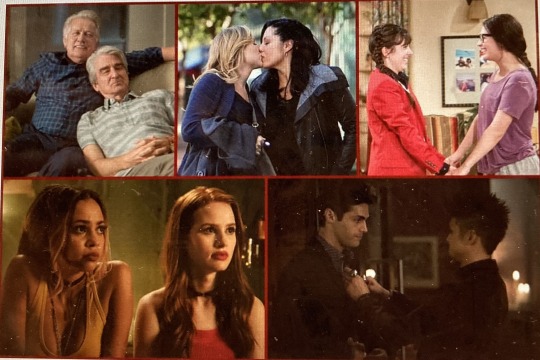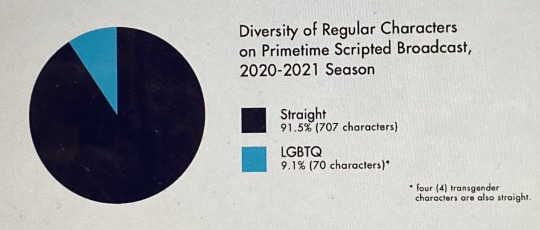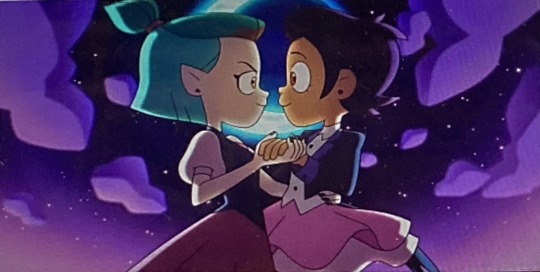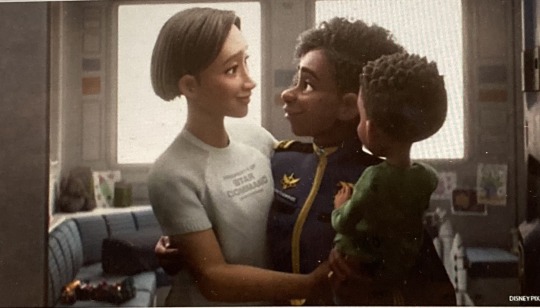Don't wanna be here? Send us removal request.
Text
LGBTQ+ Representation In Media

The world is changing every day, and people and their beliefs are changing with it, including how normal it is to be a part of the LGBTQ+ community. However, it is still a struggle for some to accept the LGBTQ+ community, and every coming out story is different. But even though these stories are just as important for people to know about, they are often misrepresented. Even in this current age, media is still struggling to provide accurate LGBTQ+ representation. From negative portrayals, overdramatic writing, and lack of LGBTQ+ actors to queerbaiting and censorship, it is clear work still needs to go into the media industry.

The LGBTQ+ community is continually underrepresented, and even when it is in the spotlight, it is not portrayed in the best way. According to the National Library of Medicine’s article, “Gay, Lesbian, and Bisexual Content on Television: A Quantitative Analysis Across Two Seasons” by Deborah Fisher, it states that aspects of a character’s sexuality were considered “too sensitive” to be seen or discussed on TV in the past. One of these themes is sexual issues related to the LGBTQ+ community: “Despite the lifting of some longstanding taboos over the last several decades, television programming has been called “compulsory heterosexual” (Wolf & Kielwasser, 1991), and depictions of the sexual issues associated with nonheterosexuals1 may remain relatively rare (Brown, 2002)” (Fisher). This encouragement of heterosexual relationships and lack of support for LGBTQ+ is continually hurting representation.
But the issue goes back further than that. According to a study from the University of Tennessee at Chattanooga by Carson Cook, the earliest depiction of homosexuals were negative. They were depicted as child molesters, victims of violence, or drag queens (Cook). This kind of representation made people uneasy about being gay, and would have a negative impact on people’s ability to come out of the closet. Throughout the 1970s-80s, some TV shows would have gay characters shown in positive light, but they never stayed very long:
“… always for a single episode, not as a recurring character (Netzley 969). In these occurrences, the character’s homosexuality was presented as the problem of the episode, rather than just an aspect of that character, and the story was contextualized primarily by how it affected the lives of the heterosexual characters” (Cook).
This short-lasting representation is bad for the LGBTQ+ community because not only is an LGBTQ+ character not given a lot of screentime, but their sexuality is seen as an issue when it should not matter. People are people regardless of who they are attracted to, which is why the LGBTQ+ community craves to be seen for who they actually are. They do not want conflict; they just want people to realize that being gay, bi, asexual, non-binary, etc. is normal. If heterosexuals can have countless accurate representations in media, why can’t the LGBTQ+ community?
youtube
In this video, the Youtuber, Wolficide, discusses the issues with media representing the LGBTQ+ community. He is really tired of seeing the same stories being told in every TV show. Wolficide admits there is good representation in kids cartoons like Adventure Time and She-Ra and the Princesses Of Power, but that is also where the problem lies. Wolficide states that good representation is ONLY seen in children’s cartoons. It is progress on creating more accepting LGBTQ+ content, but it is just one-stepping stone. More shows need to present the LGBTQ+ community in a healthier light; do not make it the main focus, just make it casual. Let it be normal for a guy and a guy to fall in love like how a guy and a girl can fall in love, for instance.
However, people in media need to be cautious with how they write LGBTQ+ characters. Katelyn’s Thomson’s academic journal, “An Analysis of LGBTQ+ Representation in Television and Film” points out that representation can be good for normalizing gender and sexual differences, but it can also easily reverse progress as well:
“Marshall (2016) also points out that while these representations show a clear progression in the number of representations, they often prompt viewers to accept stereotyped portrayals of gender and sexual differences as normal, which can have a regressive effect advancement of acceptance towards queer individuals” (Thomson, 2).
While representation can help normalize the LGBTQ+ community, it can also be harmful if it shows a stereotype, like gay men having a higher voice or them walking more femininely, for example. Yes, this could occur in the real world, but that is not always the case. People are different, which means how they express themselves will be different. That is a good thing, and it should be demonstrated and represented. Sarah Stevens’ scholarly journal, “Kids, Culture, And Queerness: The Progression of LGBTQ+ Representation in Children’s Media”, recognizes this importance. It states that today’s children media has a responsibility to model attitudes/behaviors that can better communication and increase positive interactions:
“… media exposure may lead to “social inclusion, increased literacy, and improved socioemotional skills,” while also warning that the behaviors that children learn from media are difficult to separate from their content” (Stevens).
Having media exposure to LGBTQ+ characters will allow understanding to grow and flourish, and help eliminate the negative stereotypes against the community.

However, even when there are LGBTQ+ characters, the representation can still fall short if they are not played by LGBTQ+ actors or are the victims of queerbaiting. In the article “2SLGBTQ+ Representation in the Media” from the website Media Arts, when films and TV shows are casting actors, media content like Moonlight, Transparent, and Prom had straight and/or cisgender actors play gay or trans characters. A journalist, Liam De Brún, reveals that there is a history of “straight and cis actors winning accolades for playing 2SLGBTQ+ characters, arguing that ‘it’s not brave playing a gay man, in fact you stole the role from a member of the LGBTQ community’ ” (Media Arts). I agree with this because LGBTQ+ characters should be played by LGBTQ+ actors, otherwise it undermines the intention of those characters. And queerbaiting is just as harmful because it leads fans hopeful for LGBTQ+ representation, but it does not confirm it during a show. One example is the Legend of Korra. The main character, Korra, was revealed to be in a relationship with her teammate Asami after the show was over: “This kind of after-the-fact representation, though, is in some ways worse than nothing, since it reinforces the idea that queer relationships cannot be shown openly” (Media Arts). Providing representation after a show is over is insulting to the LGBTQ+ community, and does not provide the acceptance they need.
People pay attention to how the LGBTQ+ community is portrayed, so it is important that people in media get it right. Tessa Kaur’s blog, “Queer representation in media: the good, the bad, and the ugly”, states that proper representation helps fight off stereotypes and hateful ignorance towards the LGBTQ+ community. The reason it works is because if people see LGBTQ+ characters in media, this “normalises the existence of queerness. And when these characters have compelling inner lives and relatable struggles, queer existence is destigmatised” (Kaur). Having positive representation allows the LGBTQ+ community to be seen, and helps people become more accepting of them.
youtube
In this video, the Youtuber, Its’s Rebecca Rose, talks about how the Disney show, The Owl House, has made monumental strides in this direction. The cast is made of queer characters, with the main character Luz Noceda being bi, her love interest Amity Blight being gay, supporting characters Raine Whispers and Masha being non-binary, and many others.

It was a wonderful show, but what made it especially great was that sexuality was not a major part of the story. It was simply revealed, and the story went on. This is what LGBTQ+ people want and what younger audiences need to see. LGBTQ+ characters can be all-round characters, and this can help future shows who strive to incorporate LGBTQ+ representation.

But while LGBTQ+ representation is important and viewers want it, everyone is not on the same page. The United States has produced several television shows and films with LGBTQ+ characters like The Owl House and Lightyear, but other countries are not willing to air their original content. On Twitter, the non-binary voice actor of Raine Whispers, Avi Roque, revealed that in the Latin American Spanish dub version of The Owl House, Raine’s pronouns were changed from they/them to he/him. This greatly upset Roque and several TOH fans. Raine Whispers made history as the first non-binary character to be introduced in a Disney show, and for another version of the show to depict them with he/him pronouns is highly offensive towards Roque, the show, and the fans.

In addition, the film Lightyear faced discrimination because of a scene between an LGBTQ+ couple. According to an Out magazine article, “A Movie Theater Said It Would Fast-Forward ‘Lightyear’s Same-Sex Kiss” by Mey Rude, it states that not only did the film get banned in Middle Eastern countries for a kiss between a same-sex couple, but it was also getting the same censorship in the United States. When it was revealed an Oklahoma theater would be censoring the kiss, local resident Patricia Kasbek responded, “ ‘I told them that it was completely insulting for them to censor a same-gender kiss when they've never done this to an opposite-gender kiss’ ” (Rude). This complaint demonstrates that fans were unhappy about the film being unfairly censored, and feel they should have the representation in the film uncut.
youtube
This news video from Sky News Australia confirms Lightyear was banned from 14 nations because of the kiss from the same-sex couple. This kind of censorship makes it appear that it is shameful to be gay, and that is hurtful for young audiences because they need to see it the most.
We cannot undo the harm done in the past, but we can create a more accepting generation of people in the present and future. We just need to open more opportunities in media to generate it.
Citations
“2SLGBTQ+ Representation in the Media.” Media Smarts, Canada’s Centre For Digital And Media Literacy, 2021, https://mediasmarts.ca/digital-media-literacy/media-issues/diversity-media/2slgbtq-representation/2slgbtq-representation-media. Accessed 29 Apr. 2023.
Cook, Carson. “A Content Analysis of LGBT Representation on Broadcast and Streaming Television.” Scholar.Utc, May 2018, scholar.utc.edu/cgi/viewcontent.cgi?article=1133&context=honors-theses.
“Diversity of Regular Characters on Primetime Scripted Broadcast, 2020-2021 Season Statistic Picture 3.” World Economic Forum, 2023, https://www.weforum.org/agenda/2021/01/lgbtq-characters-representation-tv-report/. Accessed 29 Apr. 2023.
Fisher, Deborah A, et al. “Gay, Lesbian, and Bisexual Content on Television: A Quantitative Analysis across Two Seasons.” Journal of Homosexuality, 4 Oct. 2007, www.ncbi.nlm.nih.gov/pmc/articles/PMC2000838/.
It’s Rebecca Rose, director. LGBTQ+ Representation in The Owl House. YouTube/ LGBTQ+ Representation in The Owl House, It’s Rebecca Rose, 14 May 2021, https://www.youtube.com/watch?v=ENPjsY4igIo. Accessed 28 Apr. 2023.
Kaur, Tessa. “Queer Representation in Media: The Good, the Bad, and the Ugly.” Heckin.Unicorn, 6 Oct. 2021, https://heckinunicorn.com/blogs/heckin-unicorn-blog/queer-representation-in-media-comprehensive-list-breakdown-lgbt?currency=USD. Accessed 28 Apr. 2023.
Misasi, Mads. “36 Greatest LGBTQ+ Television Couples from the Past Ten Years Picture 1.” Tell-Tale TV, 31 Jan. 2019, https://telltaletv.com/2019/01/36-greatest-lgbtq-television-couples-from-the-past-ten-years/. Accessed 29 Apr. 2023.
Morales, Adrianne. “Luz Noceda, Right, with Amity on ‘The Owl House.’ Disney Television Animation Picture 4.” Disney Confirms Its First Bisexual Lead Character, Who Is Also Multi-Cultural, CNN, 15 Aug. 2020, https://www.cnn.com/2020/08/15/us/disney-bisexual-trnd/index.html. Accessed 28 Apr. 2023.
“Of the 118 Films GLAAD Counted from the Major Studios in 2019... Picture 2.” Glaad, 2019, https://www.glaad.org/sri/2020/overview. Accessed 29 Apr. 2023.
Roque, Avi. “‘Avi Roque about Raine’s Change in Latin America’ (Tweet) Picture 5.” Twitter, Avi Roque, 10 Sept. 2021, https://twitter.com/ok_roque/status/1436386020899975169. Accessed 1 May 2023.
Rude, Mey. “Disney Pixar Lightyear Picture 6.” A Movie Theater Said It Would Fast-Forward ’Lightyear’s Same-Sex Kiss, Out, 23 June 2022, https://www.out.com/film/2022/6/23/movie-theater-said-it-would-fast-forward-lightyears-same-sex-kiss#toggle-gdpr. Accessed 28 Apr. 2023.
Sky News Australia, director. Buzz Lightyear Film Banned over Kiss. YouTuber/ Buzz Lightyear Film Banned over Kiss, Sky News Australia, 16 June 2022, https://www.youtube.com/watch?v=igk-y5lRQjg. Accessed 28 Apr. 2023.
Stevens, Sarah. “Kids, Culture, and Queerness: The Progression of LGBTQ+ Representation in Children’s Media .” Mahurin Honors College, 2022, digitalcommons.wku.edu/cgi/viewcontent.cgi?article=1991&context=stu_hon_theses.
Thomson, Katelyn. “An Analysis of LGBTQ+ Representation in Television and Film.” Scholars.Wlu, 2021, scholars.wlu.ca/cgi/viewcontent.cgi?article=1053&context=bridges_contemporary_connections.
Wolficide, director. The Issues With LGBT Representation In Media. YouTube/ The Issues With LGBT Representation In Media, Wolficide, 24 July 2021, https://www.youtube.com/watch?v=wEa0xvIOcCo. Accessed 28 Apr. 2023.
1 note
·
View note